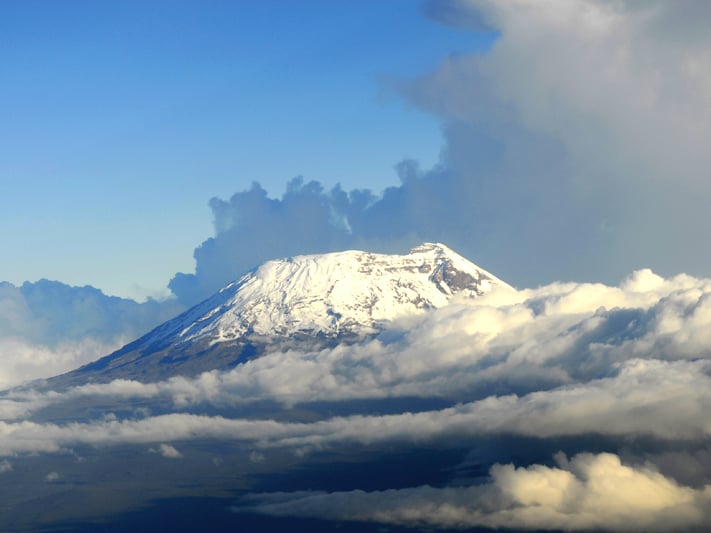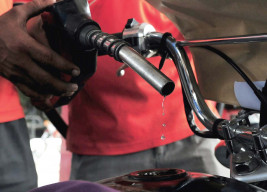
I’d been climbing this mountain for four days already, and I wasn’t going to give up.
It was 1am, below freezing and it really felt as if I could die (or at least lose a finger or two to frostbite). I couldn’t stop wheezing.
My nose was running down my upper lip, then freezing instantaneously, making my skin raw.
My lungs didn’t feel as though they were inflating, and each breath was painful – like knives stabbing my insides.
With every step, I became increasingly worried— but I wasn’t going to give up. I was going to reach the peak of Kilimanjaro.
I’d planned this trip ten years ago in a quick conversation with my best friend, who was surprised and fascinated that my mother was born in Moshi, base camp Kilimanjaro.
Over the years, we’d spoken intermittently about attempting the climb, but it wasn’t until this past January that I broached the subject again.
I was moving back to Pakistan; he was going to begin medical school. We couldn’t think of a better time to actually do the hike.
I had never exactly been the robust sporty type. Sitting out in the sun for too long would give me debilitating headaches.
If someone in a five mile radius had a cold, virus, the flu, I’d contract symptoms less than five minutes later.
In high school, I barely made it through an academic year without breaking something — my foot, my right thumb.
Every semester, I came close to failing out, despite my impeccable grades, because of my excessive absences.
Until my freshman year of college, I couldn’t get my body to weigh more than 98 lbs.
In graduate school, I was so anaemic that I received red blood cell transfusions twice in three months.
Almost everyone I spoke to about the climb looked disconcerted. A former roommate raised her eyebrows and asked me if I was serious, trying hard not to laugh out loud.
My younger brother seemed amused and skeptical when I asked him if I could borrow his backpack. In response, I began running every day – thought that meant clutching my sides and gasping for air every three minutes.
The first time I finished a mile without stopping, I almost burst into tears – from pain, more than joy.
I sat with guidebooks and online reviews, trying to figure out which agency I wanted to climb up the mountain with.
On phone calls with my friend, I read aloud passages of what we could expect.
Ignoring every piece of advice that suggested that hiking Kilimajaro wasn’t for people like me - i.e., people who decided to climb up Africa’s highest mountain on a whim – we picked the Machame route, one of the hardest ascents up the mountain. The fear that I wasn’t ready started nagging me just two weeks before my climb, but I successfully quashed it.
The first night, I slept like a rock on a Therm-a-Rest and borrowed sleeping bag.
I quickly learned how to pee in under thirty seconds, while glancing around to make sure no one was approaching.
I gave up basic ideals of hygiene, using water that had obvious specks of dirt to brush my teeth.
I popped Imodium like it was candy, hoping that I wouldn’t actually need to have a bowel movement on the side of the mountain.
I used my camera as a crutch, deciding that I needed to stop for gorgeous photographs just so I could catch my breath.
By the end of day four, I was wrecked. I could barely keep my dinner down (altitude sickness, which I definitely had, feels a lot like the flu).
I’d combated a splitting headache for half the day, and slowed my entire group down.
I was exhausted beyond anything I’d experienced before. We were going to get about four hours of sleep before we would attempt the final ascent in the middle of the night, hoping to catch the sunrise from the rooftop of Africa.
I slept fitfully, terrified that I wouldn’t be able to make it all the way up to Uhuru, the highest peak.
Three hours after we had begun the final ascent, I was sitting on a rock, breathing shallowly.
Idle patches of snow surrounded us, stark against the volcanic sand. One of the guides had taken my backpack, and handed me some water.
I took a few sips, frustrated beyond reason. My body wasn’t sore, something I’d been both expecting and worrying about; my legs felt as though they’d manage to make it up to the top. It was my lungs that had given out on me.
The group surrounded me and in the light of my headlamp I looked at the concern etched on their faces. Then I willed myself to get back up and start walking again.
Five minutes later, I was leaning on another rock, trying to get air back into my lungs.
I could hear the guides around me speaking in Swahili. Someone said the world oxygen.
Another group stopped, and their guides hovered over me as well. Finally, our head guide put his hand on my shoulder. “I think that it would be best if you descended,” he said.
I began crying. “I am not going back down,” I said furiously, but each word was punctuated by a gasp of air.
Finally, my friend intervened, shaking his head slightly to indicate that he too believed a descent would be best. I was going to have to give up. I shakily began walking back down the mountain with one of our guides, as the rest of my group continued without me.
I descended about 2,000 meters in 6 hours, stopping briefly to nap. Sulphuric ash burned the back of my throat, and the sun was unrelenting as I scrambled down the mountain.
For the first two hours, we stopped periodically as I vomited, coughing up chunks of bile while leaning over.
It wasn’t until we got back down to our camp, that I realised just how awful I had been feeling.
When, five hours later, the rest of my group joined me, all covered in volcanic ash, they still looked better than I had at 5,100 meters, the highest point I’d reached.
Later, I learned that I’d probably had a pulmonary edema, a potentially fatal side effect of gaining altitude too quickly. Only way to avoid certain death? Descend as fast as possible. A day earlier, a man had died on the Machame trail because he didn’t tell his guides how horrible he’d been feeling.
So no, I didn’t get to stand at the summit of Mount Kilimanjaro.
But I learned something valuable in the six days I spent on that mountain. My body is capable of so much more than I ever understood. It had taken me months to transform myself from the sickly, weak girl that I used to be, but I wasn’t her anymore. I no longer got a cold simply because I stayed up past 3am with my friends before heading to work at 6:30 the following morning.
I’d learned to run 5km in 27 minutes. I had some serious calf muscles and stamina.
As we sat in the shuttle back to Moshi, I grinned at my friend.
“Inca trail next?” I asked.
He grinned right back. “I’m in if you’re in.”
Sneak Peak
1. Kilimanjaro is composed of three distinct volcanic cones: Kibo (19,341 ft), Mawenzi (16,893 ft) and Shira (13,000 ft).
2. Uhuru Peak is the highest summit on Kibo’s crater rim.
3. Moshi is a Tanzanian municipality situated on the lower slopes of Mount Kilimanjaro.
4. There are six official trekking routes by which to climb Mt Kilimanjaro, namely: Marangu, Rongai, Lemosho, Shira, Umbwe and Machame. Of all the routes, Machame is by far the most scenic route up the mountain.
5. The Kilimanjaro National Park shows that only 41% of trekkers actually reach the Uhuru summit.
Published in The Express Tribune, Ms T, November 25th, 2012.
Like MsT on Facebook and follow at @TribmagMsT for your dose of girl talk





















COMMENTS
Comments are moderated and generally will be posted if they are on-topic and not abusive.
For more information, please see our Comments FAQ